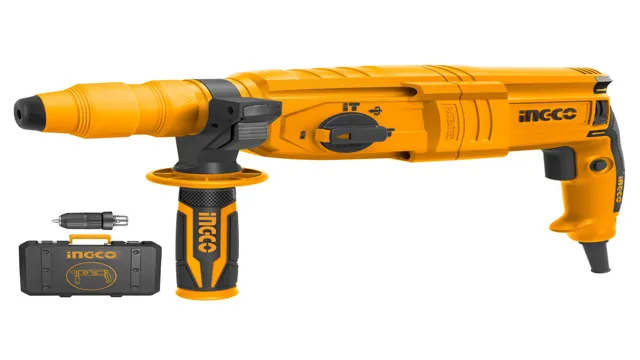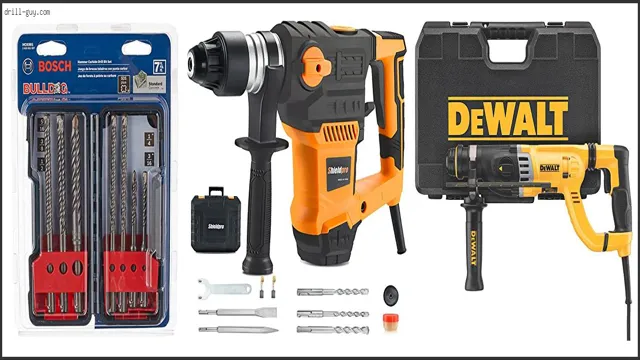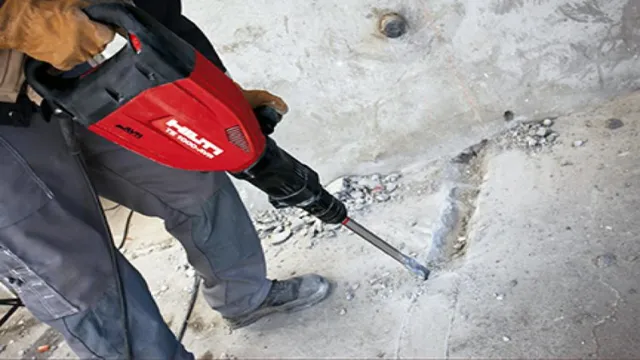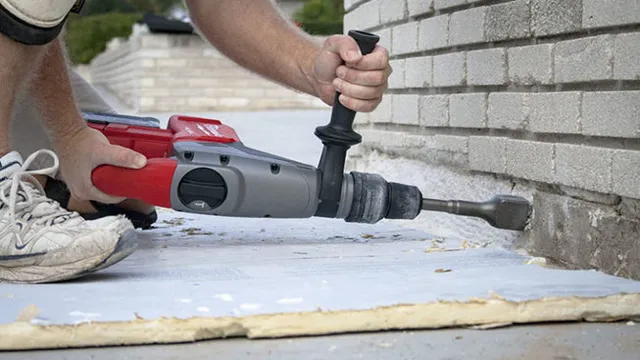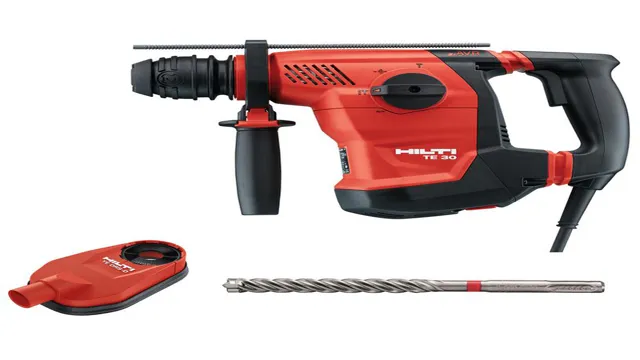How Rotary Hammer Drill Works: Understanding the Mechanism Behind Efficient Drilling
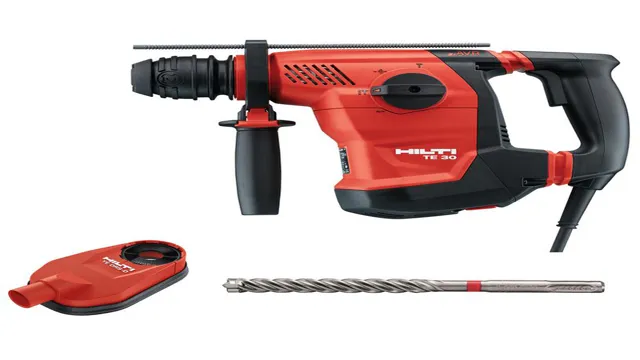
Do you know what a rotary hammer drill is? If you’re a DIY enthusiast or a professional builder, this tool is a must-have in your toolkit. It’s a versatile machine that can make your drilling tasks much easier and more efficient. But understanding its features and capabilities can be a bit confusing at first.
That’s why we’ve created this guide to help you gain a better understanding of rotary hammer drills and how they work. By the end of this article, you’ll be equipped with the knowledge you need to choose the perfect rotary hammer drill for your needs. So, let’s get started!
What is a Rotary Hammer Drill?
A rotary hammer drill is a powerful tool that combines the capabilities of a hammer drill and a rotary drill into one piece of equipment. It works by using a piston mechanism to create a high level of force that transfers the energy into the drill bit. The piston mechanism moves back and forth rapidly, which provides the necessary power to drill into tough surfaces such as concrete or brick.
Unlike a regular hammer drill, a rotary hammer drill has a chisel setting that allows it to break up concrete or other materials. This is achieved through a special function that oscillates the drill bit back and forth, creating a chiseling motion. The technology behind the rotary hammer drill has significantly improved over the years, and modern models can provide even more power and performance than their predecessors.
All in all, a rotary hammer drill is an essential tool for anyone looking to tackle tough construction projects efficiently and effectively.
Different Types of Rotary Hammer Drills
A rotary hammer drill is a powerful tool used for drilling into hard materials like concrete, stone, or brick. It works by using a piston mechanism that delivers a high impact force to the drill bit, allowing it to tackle tough materials with ease. There are several types of rotary hammer drills on the market, each with their own unique features and capabilities.
The most common are SDS-plus, SDS-max, and spline shank models. SDS-plus drills are smaller and lighter, making them ideal for DIY or light-duty work. SDS-max drills are larger and heavier, perfect for heavy-duty commercial use.
Spline shank drills are the strongest and most durable but are less common and more expensive. Choosing the right rotary hammer drill will depend on the type of work you plan to do, so it’s important to consider your needs before making a purchase. With the right tool in hand, you can tackle even the toughest drilling jobs with ease.

Components of a Rotary Hammer Drill
A rotary hammer drill, also known as a hammer drill, is a powerful tool designed for drilling through tough materials like concrete, masonry, and stone. Compared to regular drill machines, the rotary hammer drill is more capable of tackling heavy-duty drilling tasks, thanks to its unique mechanism for delivering high impact force. This mechanism is composed of several components, including a powerful motor, a clutch assembly, a hammering mechanism, and a drill chuck.
The motor is responsible for generating the torque needed to power the drill bit, while the clutch assembly regulates the amount of torque for smoother operation. The hammering mechanism, also known as the percussion mechanism, delivers the high-impact force needed to cut through hard surfaces. The drill chuck holds the drill bit in place and allows for quick and easy bit changes.
Overall, the rotary hammer drill is a versatile tool that can handle various drilling tasks with ease. Its efficient design and robust components make it a reliable and long-lasting tool that professionals and DIY enthusiasts alike can rely on. So if you’re looking for a tool that can handle tough drilling jobs, consider investing in a rotary hammer drill.
How Does a Rotary Hammer Drill Work?
Rotary hammer drills are powerful tools that are designed to bore through tough surfaces such as concrete, brick, masonry and other hard materials. Unlike regular drills, they rely on a piston mechanism to deliver high-impact blows to the end of the bit, allowing it to penetrate stubborn surfaces with ease. The way the rotary hammer drill works is by delivering high-power motion to the drill bit, which is then transferred to the surface being worked on.
The drill bit spins while simultaneously oscillating back and forth, creating a hammering effect. This delivers an intense yet controlled force that makes the boring process quick and efficient. In addition, most rotary hammers come equipped with a clutch mechanism that helps to prevent the drill from binding or stalling during the process.
This mechanism engages when the bit comes into contact with something hard and the drill bit will stop automotically to prevent damage. Rotary hammer drills are certainly more specialized, but they are also much more powerful when working with hard materials such as concrete.
Hammering Mechanism
A rotary hammer drill operates on a hammering mechanism that works in a similar way to a jackhammer. The drill rotates like a regular drill, but it also has a piston that moves back and forth, striking a chisel and causing the drill bit to hammer as it rotates. This mechanism allows rotary hammer drills to drill into hard materials like concrete and masonry, as well as serve as a powerful tool for demolition work.
The piston is powered by an electric motor that drives fluid into a sealed chamber, which then drives the piston forward. When the piston reaches its limit, a spring brings it back, providing the hammer effect. The combination of rotational and hammering forces can create a lot of power, making rotary hammer drills ideal for heavy-duty tasks.
With the right bit attachment, these drills can also be used for lighter work such as drilling through wood and metal. Overall, the hammering mechanism is the driving force behind a rotary hammer drill and its ability to tackle tough jobs.
Rotation Mechanism
A rotary hammer drill is a powerful tool that is used to create holes in tough materials, such as concrete and masonry. But, how does it work? The rotation mechanism is what makes a rotary hammer drill different from a regular hammer drill. Instead of just rotating, it also has a hammering action that allows it to break through tough surfaces.
The hammering action comes from two pistons that move back and forth inside the tool, hitting a small steel rod that then hits the bit, creating the necessary force to drill through hard surfaces. The rotation part of the mechanism is what allows the drill bit to move smoothly and quickly through the hole. This combination of hammering and rotating action is what makes a rotary hammer drill so effective and efficient for tough jobs.
So, if you need to drill through concrete or masonry, a rotary hammer drill is the tool for you!
Impact Energy
A rotary hammer drill is a powerful tool that is specifically designed to drill into tough materials like masonry, concrete, and granite. It works by using an impact energy mechanism – a system of gears, pistons, and a hammer – to convert the rotary motion of the drill bit into a powerful and rapid hammering motion that breaks up the hard surface and helps to drive the bit through the material. The impact energy is measured in joules and is a critical factor in the performance of a rotary hammer drill.
The higher the impact energy, the more power the drill has to break through the hard surface. The keyword for this article is ‘impact energy’, and it is essential for anyone looking to buy a rotary hammer drill to understand how it works.
Choosing the Right Rotary Hammer Drill for Your Needs
If you’re looking to complete heavy-duty drilling tasks, a rotary hammer drill may be just what you need. But how does a rotary hammer drill work? Unlike regular drills that use a rotating motion to drill holes, rotary hammer drills use a combination of rotation and percussion to drill through tough materials like concrete and masonry. The drill bit not only rotates but also moves back and forth rapidly, delivering a powerful blow each time it hits the material.
This process is what makes a rotary hammer drill so effective and efficient at drilling through thick walls and floors. When choosing a rotary hammer drill, it’s important to consider the size of the drill and the type of job you need it for. A smaller drill will work well for lighter tasks while a larger drill is best suited for heavy-duty jobs.
Overall, rotary hammer drills are an excellent choice for those tackling construction projects and need a powerful tool that can handle the job.
Considerations when Choosing a Rotary Hammer Drill
When choosing a rotary hammer drill, there are several factors to consider to ensure you get the right tool for your job. One of the most important factors is the size of the job. If you are working on a big project that requires a lot of power, a larger hammer drill may be necessary.
Another factor to consider is the type of material you will be drilling through. Different materials require different drill bits and levels of power. It’s also important to consider the ergonomics of the drill, as a comfortable grip will allow you to work for longer periods without fatigue.
Lastly, make sure to consider the brand you are purchasing from, as reputable brands will provide better durability and reliability. By taking all these factors into account, you can choose a rotary hammer drill that is perfectly suited for your needs.
Top Brands in Rotary Hammer Drills
When it comes to getting work done around the house or on a job site, having the right tools is essential. Rotary hammer drills are versatile and powerful tools that are perfect for a wide variety of tasks, including drilling through concrete and masonry. But with so many brands out there, it can be difficult to choose the right one for your needs.
Some top brands to consider include Bosch, DeWalt, and Makita. Each of these brands offers a range of rotary hammer drills with different features and capabilities, so it’s important to consider what you need the tool for and which brand offers the best fit. Some things to consider when choosing a rotary hammer drill include the size and weight of the tool, the power output, and whether it includes any extra features like a built-in dust extractor or variable speed control.
Ultimately, the right rotary hammer drill for you will depend on your individual needs and preferences, but by considering some of the top brands and their features, you can make an informed decision that will help you get the job done right.
Conclusion: Making the Most of Your Rotary Hammer Drill
In conclusion, a rotary hammer drill is like a superhero with a dual personality. It can switch between regular drilling mode and superhero hammering mode, depending on the task at hand. Its secret weapon is a piston that pounds the drill bit forward, breaking through the toughest materials like a hot knife through butter.
A rotary hammer drill is not your average drill, it’s a force to be reckoned with, and it’s ready to save the day when you need holes to be drilled in concrete, brick, or stone. So, the next time you need some drilling done, call upon the rotary hammer drill to get the job done right, the first time around!”
FAQs
What is a rotary hammer drill, and how does it work?
A rotary hammer drill is a tool that combines a hammering action and a rotating action to drill through tough materials like concrete and masonry. The hammering action provides a powerful force to break up the material, while the rotating action helps to clear away debris and facilitate drilling.
What are the different types of rotary hammer drills available on the market?
There are three main types of rotary hammer drills: corded, cordless, and SDS-max. Corded models are powered by electricity and offer consistent power output, while cordless models offer greater portability and convenience. SDS-max models are designed for heavy-duty drilling tasks and offer higher impact energy compared to other models.
What materials can be drilled using a rotary hammer drill?
A rotary hammer drill is typically used to drill through hard materials like concrete, masonry, and stone. It can also be used to drill through metal, wood, and other materials.
Is it possible to use a rotary hammer drill for chiseling or demolition work?
Yes, many rotary hammer drills come with chisel attachments that allow for easy demolition work. This is particularly useful for breaking up concrete or masonry.
What safety precautions should be taken when using a rotary hammer drill?
It is important to wear safety glasses and ear protection when using a rotary hammer drill. It is also important to follow the manufacturer’s instructions and guidelines, including using the proper drill bit and ensuring the drill is properly secured before use.
Can a rotary hammer drill be used for drilling in tight spaces or overhead?
Yes, many models of rotary hammer drills are designed with a compact size and ergonomic grip that makes it easier to use in tight spaces or overhead drilling.
How can I maintain my rotary hammer drill for optimal performance?
To maintain optimal performance, it is important to clean and lubricate the drill regularly, inspect and replace worn or damaged parts as needed, and avoid overloading the drill by using the proper bit and drilling speed. It is also important to store the drill in a dry and safe location when not in use.

